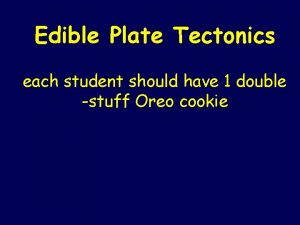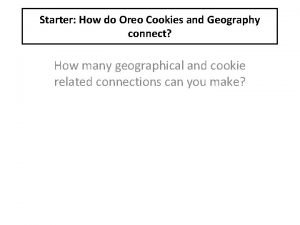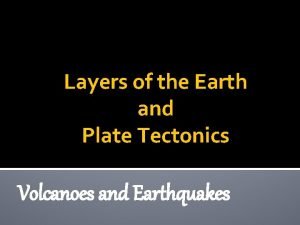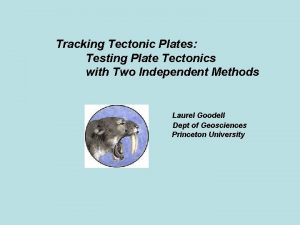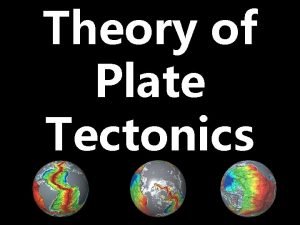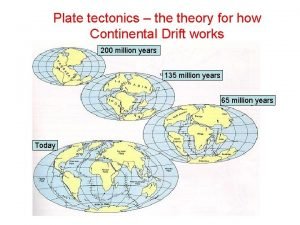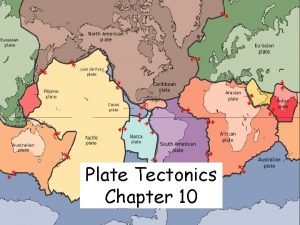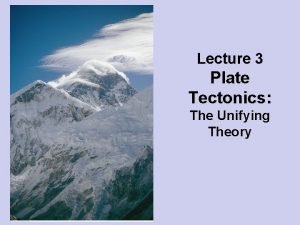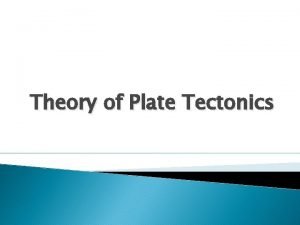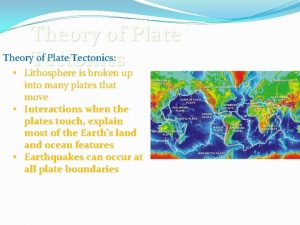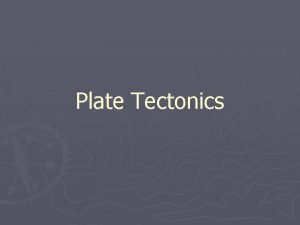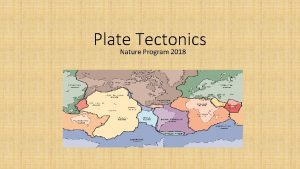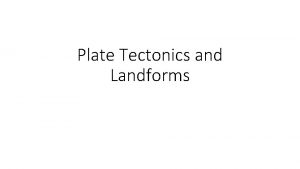OREO PLATE TECTONICS THEORY OF PLATE TECTONICS v











- Slides: 11

OREO PLATE TECTONICS

THEORY OF PLATE TECTONICS v. The theory of plate tectonics, proposed by Alfred Wegener in 1912, states that the lithosphere is made up of plates of different sizes and weights that move due to convection inside Earth’s mantle. v. Convection- as semi-solid rock is heated, it expands and becomes lighter. Gravity forces down the cooler, heavier rock, which sinks or collides with the lighter rock. v. This explains why and how earthquakes and volcanoes are likely to occur within certain areas as well as how new crust forms along the ocean floor. v. The asthenosphere is the layer just below the lithosphere. While in motion, the plates interact with each other at their boundaries, or at their edges.

THEORY OF PLATE TECTONICS v. During plate movement, plates will interact in various ways. The plates may move toward one another, converge, or collide. Other options of plate movement include them pulling apart from one another, or sliding alongside each other. v. The movements of the plates are referred to as their plate boundaries. The types of plate boundaries are classified according to their movement. The main types of plate movements include: v. Convergent Plate Boundaries v. Divergent Plate Boundaries v. Transform Plate Boundaries

OREO #1: SLIDING PLATE Directions: v. Carefully without breaking the cookie remove the top cookie. v. Then slide this top portion of the cookie over the filling. v. Once completed, describe and illustrate the changes made to your cookie in the section marked “Theory of Plate Tectonics”. This represents the movement of a plate sliding.

CONVERGENT PLATE BOUNDARYv. With convergent plate boundaries the plates are moving toward each other, or converging. There are two types of convergent plate boundaries: v. Subduction Boundaries v. Collision Boundaries v. Subduction boundaries occur when an oceanic plate goes beneath another plate (subducting). These can occur when: v. Two oceanic plates converge. They will form a deep-sea trench, which is followed by the formation of a chain of volcanic islands. Ex. : the Mariana Trench that has created the volcanic Mariana Islands. v. An oceanic plate and a continental plate converge. When oceanic plates converge with continental plates, the denser oceanic plate subducts beneath the continental plate. A deep sea trench is formed, and then a mountain chain and volcano may form.

CONVERGENT PLATE BOUNDARY v. Collision boundaries are also considered convergent boundaries. These boundaries occur when: v. Two converging plates carry continents- these two continents generally become glued together, creating one larger continent. This collision generally will cause one plate to be pushed upward into a mountain range. Ex. Creation of the Himalaya Mountains.

OREO #2: CONVERGENT PLATE BOUNDARY Directions: v. Carefully break the top cookie of your Oreo in half. (Do not break the bottom cookie) v. Then bring the broken parts together in the center of the Oreo. v. Once completed place your cookie on your portion of your paper marked convergent. This represents a convergent boundary.

DIVERGENT PLATE BOUNDARY v. When two lithospheric plates move away from each other they are considered to be a divergent boundary. v. Divergent boundaries, sometimes referred to as “spreading centers, ” occur during sea-floor spreading. Magma from the mantle will rise through the opening in the crust when the seafloor spreads apart, creating a ridge or rift. Ex. the Mid-Atlantic Ridge.

OREO #3: DIVERGENT PLATE BOUNDARY Directions: v. Carefully break the top cookie of your Oreo in half. (Do not break the bottom cookie) v. Then pull the two parts of the top cookie apart. v. Once completed place your cookie on your portion of your paper marked divergent. This represents a divergent boundary.

TRANSFORM PLATE BOUNDARIES v. Transform boundaries are when two plates slide past one another. With transform boundaries the movement of the plates is not equal. v. An example of a transform boundary is in California, where the North American plate passes along the Pacific Plate, along the San Andreas Fault. v. During this movement the Pacific Plate is moving Northwest and the North American Plates is moving southwest. v. Portions of the San Andreas Fault move as much as five centimeters per year, whereas in other sections it has not moved in over a century.

OREO #4: TRANSFORM PLATE BOUNDARIES Directions: v. Carefully break the top cookie of your Oreo in half. (Do not break the bottom cookie) v. Then pull the two parts of the top cookie pass one another, in opposite directions. v. Once completed place your cookie on your portion of your paper marked transform boundary.
 Plate tectonics with oreos
Plate tectonics with oreos Oreo cookies plate tectonics
Oreo cookies plate tectonics Picture of alfred wegener
Picture of alfred wegener The tectonic plates float on which semiliquid layer
The tectonic plates float on which semiliquid layer Continental drift vs plate tectonics theory
Continental drift vs plate tectonics theory Continental drift vs plate tectonics theory
Continental drift vs plate tectonics theory Plate motion calculator
Plate motion calculator Plate tectonics theory states that
Plate tectonics theory states that Continetial drift
Continetial drift Summarize the theory of plate tectonics
Summarize the theory of plate tectonics Explain the theory of plate tectonics.
Explain the theory of plate tectonics. Unifying theory of plate tectonics
Unifying theory of plate tectonics
